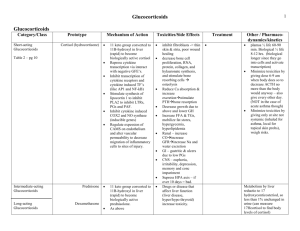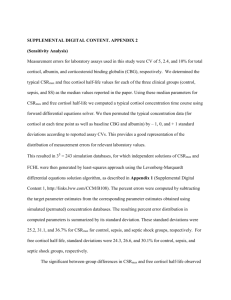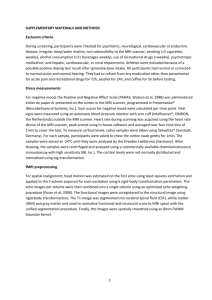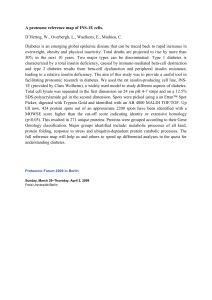The Impact of Short and Medium-Term
advertisement
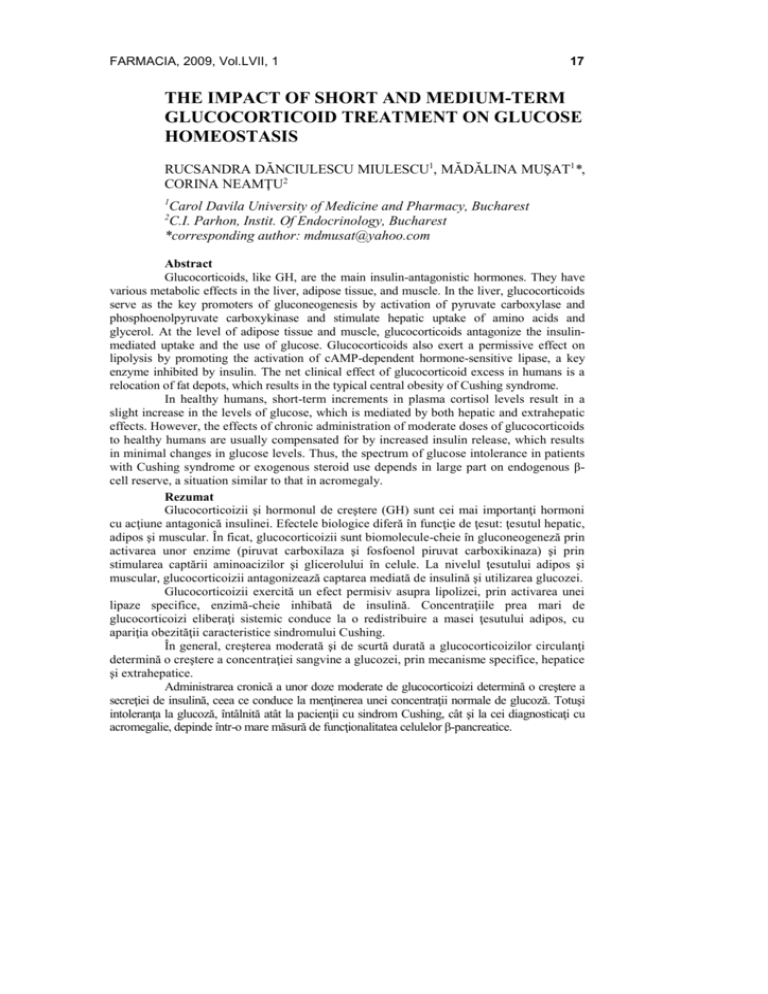
FARMACIA, 2009, Vol.LVII, 1 17 THE IMPACT OF SHORT AND MEDIUM-TERM GLUCOCORTICOID TREATMENT ON GLUCOSE HOMEOSTASIS RUCSANDRA DĂNCIULESCU MIULESCU1, MĂDĂLINA MUŞAT1*, CORINA NEAMŢU2 1 Carol Davila University of Medicine and Pharmacy, Bucharest C.I. Parhon, Instit. Of Endocrinology, Bucharest *corresponding author: mdmusat@yahoo.com 2 Abstract Glucocorticoids, like GH, are the main insulin-antagonistic hormones. They have various metabolic effects in the liver, adipose tissue, and muscle. In the liver, glucocorticoids serve as the key promoters of gluconeogenesis by activation of pyruvate carboxylase and phosphoenolpyruvate carboxykinase and stimulate hepatic uptake of amino acids and glycerol. At the level of adipose tissue and muscle, glucocorticoids antagonize the insulinmediated uptake and the use of glucose. Glucocorticoids also exert a permissive effect on lipolysis by promoting the activation of cAMP-dependent hormone-sensitive lipase, a key enzyme inhibited by insulin. The net clinical effect of glucocorticoid excess in humans is a relocation of fat depots, which results in the typical central obesity of Cushing syndrome. In healthy humans, short-term increments in plasma cortisol levels result in a slight increase in the levels of glucose, which is mediated by both hepatic and extrahepatic effects. However, the effects of chronic administration of moderate doses of glucocorticoids to healthy humans are usually compensated for by increased insulin release, which results in minimal changes in glucose levels. Thus, the spectrum of glucose intolerance in patients with Cushing syndrome or exogenous steroid use depends in large part on endogenous βcell reserve, a situation similar to that in acromegaly. Rezumat Glucocorticoizii şi hormonul de creştere (GH) sunt cei mai importanţi hormoni cu acţiune antagonică insulinei. Efectele biologice diferă în funcţie de ţesut: ţesutul hepatic, adipos şi muscular. În ficat, glucocorticoizii sunt biomolecule-cheie în gluconeogeneză prin activarea unor enzime (piruvat carboxilaza şi fosfoenol piruvat carboxikinaza) şi prin stimularea captării aminoacizilor şi glicerolului în celule. La nivelul ţesutului adipos şi muscular, glucocorticoizii antagonizează captarea mediată de insulină şi utilizarea glucozei. Glucocorticoizii exercită un efect permisiv asupra lipolizei, prin activarea unei lipaze specifice, enzimă-cheie inhibată de insulină. Concentraţiile prea mari de glucocorticoizi eliberaţi sistemic conduce la o redistribuire a masei ţesutului adipos, cu apariţia obezităţii caracteristice sindromului Cushing. În general, creşterea moderată şi de scurtă durată a glucocorticoizilor circulanţi determină o creştere a concentraţiei sangvine a glucozei, prin mecanisme specifice, hepatice şi extrahepatice. Administrarea cronică a unor doze moderate de glucocorticoizi determină o creştere a secreţiei de insulină, ceea ce conduce la menţinerea unei concentraţii normale de glucoză. Totuşi intoleranţa la glucoză, întâlnită atât la pacienţii cu sindrom Cushing, cât şi la cei diagnosticaţi cu acromegalie, depinde într-o mare măsură de funcţionalitatea celulelor β-pancreatice. 18 FARMACIA, 2009, Vol.LVII, 1 Keywords: glucocorticoids; glucose levels; β-cell reserve; diabetes; 11-β-hydroxisteroid dehydrogenase (11-β-HSD); Bcl-2-antagonist of cell death (BAD) Introduction Glucose homeostasis is maintained by the balance between insulin release and action on one hand and hyperglycemic effect of glucagon, cathecolamines, GH and cortisol, on the other hand. Disturbing the mechanisms that regulate the glycaemic control in various illnesses or by drug administration can result in the damage of glucose homeostasis in susceptible persons. Glucocorticoids are important regulators of the protein, glucose and lipid metabolism. There are a lot of common features in metabolic syndrome and Cushing syndrome suggesting that a common key factor could be the excess of cortisol that could have an important role in triggering diabetes mellitus in predisposed individuals. Despite the similarities between the two syndromes mentioned, serum or urine cortisol have not been found increased in obese patients with type 2 diabetes mellitus or insulin resistance [1-3]. Cortisol major source is the adrenal cortex, but the hormone is also produced in the omental fat [4, 5]. Released in the portal blood stream, cortisol seems to alter metabolic pathways in the liver. In obese people the levels of cortisol in adipose tissue are increased by reducing cortisone (inactive hormone) into cortisol (active) by the 11-β-hydroxisteroid dehydrogenase type 1 (11-β-HSD1) which is present in humans in adipose tissue [6] and in the liver [7]. 11-β-HSD1 is sometimes over-expressed in visceral adipose tissue as compared to subcutaneous fat and it could act as a paracrin factor, increasing cortisol in abdominal fat, but not in the systemic circulation [1]. The studies on transgenic mice overexpressing the gene coding for 11-β-HSD1 in adipocytes showed increased glucocorticoids levels in the adipose tissue and portal vein and induced visceral obesity, insulin resistance, hypertension and dyslipidemia. In contrast, 11-β-HSD1 knockout mice showed reduced gluconeogenesis, improved glucose tolerance, lower plasma triglycerides and increased plasma HDL levels. Stewart et al. suggested that increased activity of 11-β-HSD1 in mouse omental fat could be responsible for the diabetogenic effect of this tissue (”omental Cushing disease”) [8]. However, data from mouse studies cannot be extended in humans. Moreover in humans 11-β-HSD1 activity was increased in subcutaneous adipose tissue with no correlation to abdominal adiposity [9]. Recently, several catheterism studies performed during abdominal surgery for obesity have not proved any difference between cortisol level in portal FARMACIA, 2009, Vol.LVII, 1 19 vein compared to peripheric blood [1, 10]. Their conclusion is that omental 11-β-HSD1 does not have a role in increased cortisol at the hepatic level in obese people. Plasmatic cortisol levels are also normal in diabetic patients with type 2 diabetes [2, 3]. However preclinical data suggest that specific inhibitors of 11-βHSD1 could lower intracellular cortisol levels and thus may play a role in the treatment of metabolic syndrome [11, 12]. Epidemiological data sustain a beneficial effect of coffee in prevention of type 2 diabetes mellitus. Atanasov et. al. consider that these could in part be due to blocking of 11-βHSD1 activity and subsequently to low intracelular cortisol and prevention of transcription for phosphoenolpyruvate carboxykynase [13]. Though the pathogenic action of cortisol in abdominal adipocytes remain to be proved, the link between cortisol excess and obesity as in Cushing’s syndrome is beyond doubt. Acute administration of cortisol is followed by rapid installed insulin resistance and hype [14, 15]. Cortisolinduced diabetes is also proved [14]. Glucocorticoids are widely used therapeutic tools, particularly for anti-inflamatory and immunomodulatory purposes. Glucocorticoids excess induces hyperglycemia by the following mechanisms: - in the liver, glucocorticoids serve as the key promoters of gluconeogenesis by activation of pyruvate carboxylase and phosphoenolpyruvate carboxykinase and stimulate hepatic uptake of amino acids and glycerol; - insulin resistance of peripheral tissues; - glucocorticoids inhibit insulin secretion by blocking adrenoreceptor signaling or by inhibition of Kv channels; - glucocorticoids induce apoptosis of β-cells; - glucocorticoids can modulate GAD (glutamate decarboxilase) expression and may influence the development of autoimmune diabetes. Glucocorticoids induces pancreatic β-cells death Previous studies have shown a relative deficit of insulin in Cushing’s syndrome as opposed to metabolic syndrome or type 2 diabetes, which raised the suspicion of a toxic effect of cortisol on the pancreatic beta cells, as these patients had a blunted insulin release secondary to induced hyperglycaemia [16]. Glucocorticoids induce β-cells death by activating the mitochondrial apoptotic pathway. Glucocorticoids induce cell death by reduction of the antiapoptotic protein Bcl-2, the stimulation of calcineurin 20 FARMACIA, 2009, Vol.LVII, 1 and the dephosphorylation of BAD (Bcl-2-antagonist of cell death). The Bcl-2 protein family comprises of anti- and proapoptotic proteins. Some of these proteins (such as Bcl-2 and Bcl-XL) are antiapoptotic and located at the outer mitochondrial membrane, while others (such as BAD or Bax) are proapoptotic and cytosolic proteins. The proapoptotic proteins act as sensors of cellular damage or stress. Cellular stress induced by irradiation, viral infection or chemicals may result in an increase of cytosolic Ca2+ activity, which in turn activates the phosphatase calcineurin. Calciuneurin dephosphorylate BAD (BAD is bound to the cytosolic adaptor protein 14-33 in its phosphorylated form) which triggers its release from the cytosolic protein 14-3-3. This enables BAD to bind to Bcl-2 at the surface of the mitochondrial membrane. The interaction between BAD as pro- and Bcl2/Bcl-XL as antiapoptotic protein at the mitochondrial membrane disrupts the normal function of the antiapoptotic proteins. Binding of BAD leads to formation of permeability transition pores in the mitochondria and release of cytochrome c and other proapoptotic molecules from the mitochondrial intermembrane space. This in turn leads to the formation of the apoptosome and the activation of the caspase cascade which accomplishes the degradation of the nuclear DNA. The effects of glucocorticoids are antagonized by the glucocorticoid receptor antagonist RU486 and glucagonlike peptide 1 analog (GLP-1). GLP-1 protects against glucocorticoidinduced apoptosis. GLP-1 receptor activation leads to G-protein-dependent stimulation of adenylyl cyclase, cAMP formation and subsequent activation of cAMP-dependent protein kinase A (PKA). PKA was found to phosphorylate the proapoptotic protein BAD which favors the binding of BAD of the protein 14-3-3, keeping BAD in the cytosol [17]. Glucocorticoids induce insulitis and diabetes GAD is a pancreatic beta-cell autoantigen in humans and nonobese diabetic mice (NODmice). The tratment of MIN6N8a cells (NODmouse β-cells) with a synthetic glucocorticoid, dexamethasone induced the stimulation of GAD67 mRNA expression in a dose- and timedependent manner. Cells treated with 100 nmol/l dexamethasone for 6 h showed a 10-fold increase in the expression of GAD67 mRNA and an increase in GAD67 protein. The upregulation of GAD67 expression in betacells by dexamethasone was found to be due to the transcriptional activation of the GAD67 promoter. Injection of dexamethasone into neonatal NOD mice resulted in a significant increase in the expression of GAD67 mRNA in pancreatic beta-cells and the development of insulitis and diabetes. The glucocorticoid hormones can modulate GAD expression by the FARMACIA, 2009, Vol.LVII, 1 21 transcriptional activation of the GAD promoter and may influence the development of autoimmune diabetes in NOD mice [18]. Glucocorticoids and insulin resistance Glucocorticoids induce insulin resistance by several mechanisms. In adipose tissue glucocorticoids activate lipolysis with release of free fatty acids (FFA) and glycerol in the blood stream. Increased FFA contributes to insulin resistance in the striate muscle and stimulate gluconeogenesis in the liver. Glycerol serves as substrate for gluconeogenesis. Total cholesterol and triglycerides also increase, while HDL is reduced. Other biologic mediators of insulin resistance are also produced in adipocytes: adiponectin, TNF alpha (tremor necrosis factor). These are incriminated in the role of visceral fat on metabolic parameters. Glucocorticoids down-regulate adiponectin gene expression and reduce adiponectin plasma levels in humans. Adiponectin is an adipose tissue derived cytokine with multiple biofunctions including its property to increase fatty acid oxidation in skeletal muscle. Plasma adiponectin levels are reduced in clinical conditions associated with insulin resistance and it has been suggested that adiponectin may be the link between insulin resistance and the metabolic syndrome and vascular disease. The promoter of adiponectin gene – Apm1 – contains sequences that bind to glucocorticoid receptor. Dexamethasone induces decrease of adiponectin in vitro, while prednisolone administration raises the concentration of adiponectin in the blood stream. Previous studies have shown an inverse correlation between cortisol binding globulin (CBG), BMI (body mass index) and insulin resistance. There are studies which confirm that adiponectin, CBG and cortisol “á jeun” are significantly correlated in healthy subjects. Glucocorticoids have also a permissive effect on other hyperglycemiant hormones: cathecolamines and glucagon. The results of the above effects are insulin resistance and increased glycaemia. Conclusions In healthy humans, short-term increments in plasma cortisol levels results in a slight increase in levels of glucose, which is mediated by both hepatic and extrahepatic effects [19]. However, the effects of chronic administration of moderate doses of glucocorticoids to healthy humans are usually compensated by increased insulin release, which results in minimal changes in glucose levels. Thus, the spectrum of glucose intolerance in 22 FARMACIA, 2009, Vol.LVII, 1 patients with Cushing syndrome or exogenous steroid use depends in large part on endogenous β-cell reserve, a situation similar to that in acromegaly. 1. 2. 3. 4. 5. 6. 7. 8. 9. 10. 11. 12. 13. 14. 15. References Aldhahi,W, Mun,E, Goldfine,Ab: Portal And Peripheral Cortisol Levels In Obese Humans. Diabetologia 47:833-836, 2004 Homma,M, Tanaka,A, Hino,K, Takamura,H, Hirano,T, Oka,K, Kanazawa,M, Miwa,T, Notoya,Y, Niitsuma,T, Hayashi,T: Assessing Systemic 11betaHydroxysteroid Dehydrogenase With Serum Cortisone/Cortisol Ratios In Healthy Subjects And Patients With Diabetes Mellitus And Chronic Renal Failure. Metabolism 50:801-804, 2001 Marin,P, Darin,N, Amemiya,T, Andersson,B, Jern,S, Bjorntorp,P: Cortisol Secretion In Relation To Body Fat Distribution In Obese Premenopausal Women. Metabolism 41:882-886, 1992 Bujalska,Ij, Kumar,S, Stewart,Pm: Does Central Obesity Reflect "Cushing's Disease Of The Omentum"? Lancet 349:1210-1213, 1997 Walker,Br: Is "Cushing's Disease Of The Omentum" An Affliction Of Mouse And Men? Diabetologia 47:767-769, 2004 Katz,Jr, Mohamed-Ali,V, Wood,Pj, Yudkin,Js, Coppack,Sw: An In Vivo Study Of The Cortisol-Cortisone Shuttle In Subcutaneous Abdominal Adipose Tissue. Clin.Endocrinol.(Oxf) 50:63-68, 1999 Walker,Br, Campbell,Jc, Fraser,R, Stewart,Pm, Edwards,Cr: Mineralocorticoid Excess And Inhibition Of 11 Beta-Hydroxysteroid Dehydrogenase In Patients With Ectopic Acth Syndrome. Clin.Endocrinol.(Oxf) 37:483-492, 1992 Stewart,Pm, Boulton,A, Kumar,S, Clark,Pm, Shackleton,Ch: Cortisol Metabolism In Human Obesity: Impaired Cortisone- Cortisol Conversion In Subjects With Central Adiposity. J.Clin.Endocrinol.Metab 84:1022-1027, 1999 Westerbacka,J, Yki-Jarvinen,H, Vehkavaara,S, Hakkinen,Am, Andrew,R, Wake,Dj, Seckl,Jr, Walker,Br: Body Fat Distribution And Cortisol Metabolism In Healthy Men: Enhanced 5beta-Reductase And Lower Cortisol/Cortisone Metabolite Ratios In Men With Fatty Liver. J.Clin.Endocrinol.Metab 88:49244931, 2003 Basu,R, Singh,Rj, Basu,A, Chittilapilly,Eg, Johnson,Mc, Toffolo,G, Cobelli,C, Rizza,Ra: Obesity And Type 2 Diabetes Do Not Alter Splanchnic Cortisol Production In Humans. J.Clin.Endocrinol.Metab 90:3919-3926, 2005 Tomlinson,Jw, Stewart,Pm: Mechanisms Of Disease: Selective Inhibition Of 11beta-Hydroxysteroid Dehydrogenase Type 1 As A Novel Treatment For The Metabolic Syndrome. Nat.Clin.Pract.Endocrinol.Metab 1:92-99, 2005 Walker,Br: Cortisol-Cause And Cure For Metabolic Syndrome? Diabet.Med. 23:1281-1288, 2006 Atanasov,Ag, Dzyakanchuk,Aa, Schweizer,Ra, Nashev,Lg, Maurer,Em, Odermatt,A: Coffee Inhibits The Reactivation Of Glucocorticoids By 11betaHydroxysteroid Dehydrogenase Type 1: A Glucocorticoid Connection In The Anti-Diabetic Action Of Coffee? Febs Lett. 580:4081-4085, 2006 Ionescu,Tc: Continuous Glucose Monitoring: Physiologic And Pathophysiologic Significance. Rev Roum Med Int. 2004 C. I. Tîrgovişte (Coordonator)- Tratat De Diabet Paulescu, Ed. Academiei, Bucureşti, 2004 FARMACIA, 2009, Vol.LVII, 1 23 16. Friedman,Tc, Mastorakos,G, Newman,Td, Mullen,Nm, Horton,Eg, Costello,R, Papadopoulos,Nm, Chrousos,Gp: Carbohydrate And Lipid Metabolism In Endogenous Hypercortisolism: Shared Features With Metabolic Syndrome X And Niddm. Endocr.J. 43:645-655, 1996 17. Ranta F, Avram D, Berchtold S Et Al. Dexamethasone Induced Cell Death In Insulin -Secreting Cells, An Effect Reversed By Exendin-4, Diabetes 55: 13801390, 2006. 18. Kim,Ks, Kang,Y, Choi,Se, Kim,Jh, Kim,Hm, Sun,B, Jun,Hs, Yoon,Jw: Modulation Of Glucocorticoid-Induced Gad Expression In Pancreatic Beta-Cells By Transcriptional Activation Of The Gad67 Promoter And Its Possible Effect On The Development Of Diabetes. Diabetes 51:2764-2772, 2002 19. Gravholt,Ch, Dall,R, Christiansen,Js, Moller,N, Schmitz,O: Preferential Stimulation Of Abdominal Subcutaneous Lipolysis After Prednisolone Exposure In Humans. Obes.Res. 10:774-781, 2002 Manuscript received: 29.08.2008
